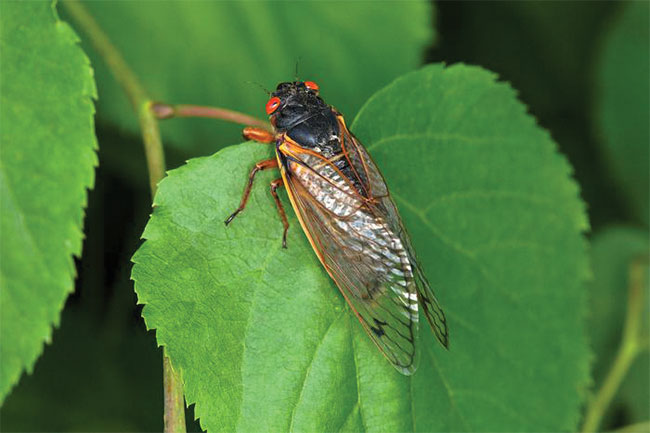It’s all the buzz
Do adult periodical cicadas actually feed on anything? The Entomological Society of America recently published a USDA-Agricultural Research Service analysis of DNA in Brood X cicadas’ gut contents. The periodical cicadas in the genus Magicicada come every 13 or 17 years, though other types may emerge much more frequently. A long-standing agricultural query related to the periodical cicadas was recently answered by a USDA-ARS research team at West Virginia’s Appalachian Fruit Research Station. Simply: Once periodical cicadas emerge, do they actually feed on vegetation?

THREAT TO AGRICULTURE
Magicicada pose a threat due to their ability to damage orchard trees when they lay their eggs on tree branches. Many growers and nurseries take this into consideration and refrain from planting new trees in years when periodical cicadas emerge, as their eggs can kill young trees.
ARS researchers investigated the best way to solve this challenge by reviewing the life history, reproductive biology and evolutionary relationships of cicadas over the past 150 years. But many have often disagreed about whether, or how much, the adults feed. This is because the needle-like mouthparts of cicadas do not leave much evidence of any feeding, unlike chewing insects, and their digestive tracts are notoriously difficult to dissect. USDA-ARS researchers studied adult male and female Magicicada during the 2021 emergence of Brood X in Maryland, Virginia and West Virginia, as the insect moved through apple orchards, wooded public parks and residential properties.
The findings, published in October in the Entomological Society of America’s open-access Journal of Insect Science, disrupted the age-old popular myth of adult periodical cicadas not feeding. Scientists found mainly woody plant and Malus, or apple tree DNA, in adult cicada guts and found that 54% of those cicadas contained DNA from multiple plant species.
While this strongly implies that adult Magicicada feed on plant sap, it was necessary to show that the recovered plant DNA was not just leftovers from meals eaten during the nymph stage.
USDA-ARS RESEARCH
“We tested teneral adults, or brand new adult Magicicada that had not had a chance to feed yet, to check for any leftover plant DNA,” James Hepler, USDA-ARS research team leader, said in a news release. “We couldn’t find any plant DNA in the guts of teneral adults, so we can be reasonably sure that the DNA found in mature adult Magicicada was eaten during the adult stage, since no DNA carries over from the nymph stage.”
Cicadas appear to have highly permeable exoskeletons that permit considerable water loss and allow water to evaporate out of the insect a little easier than many other insects. Also, the presence of essential amino acid-producing endosymbionts in the gut tissues of adult Magicicada imply that, despite the water loss, some nutrition is being derived as they feed on plant species.
USDA-ARS will continue to examine the life cycle of Brood X and solve agricultural challenges directly related to their life span above ground. More studies will also be conducted to look at the impact that adult Magicicada contribute to tree physiology.
Additionally, growers should be aware of reports from late January that indicate two broods of cicadas are expected to emerge from the ground from April through June. Affected states include Virginia to Illinois. With the prevalence of the insects, it is important for growers to be watchful of effects to crops.









 Video Library
Video Library 


















